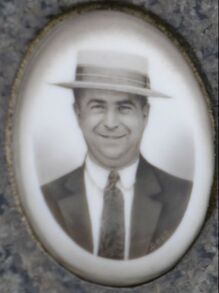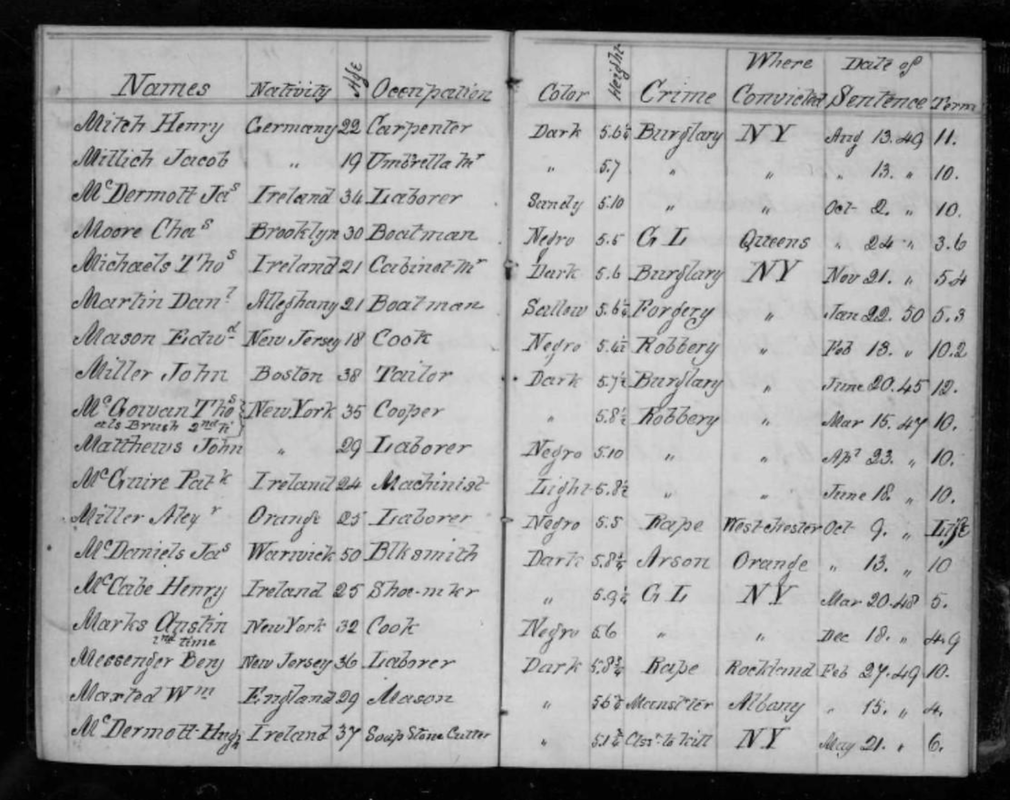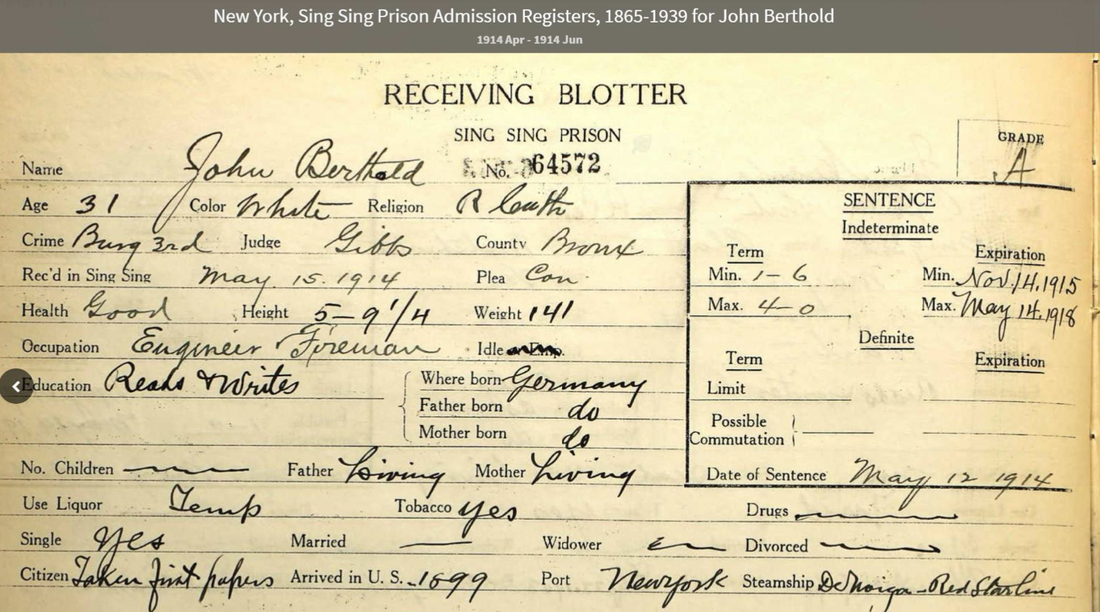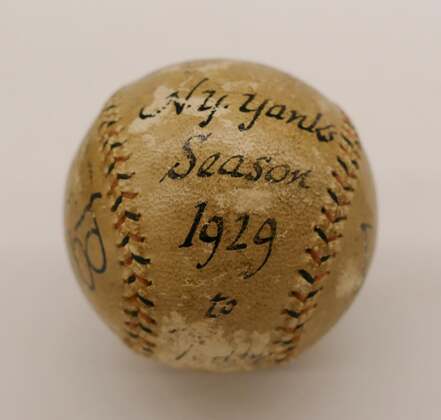|
Sing Sing Prison Museum's Executive Director, Brent D. Glass, recently published a post for the American Alliance of Museums (AAM). Shared here with permission:
4 Comments
 WHAT WE'RE READING: This month we are honored to feature an autobiography "The Urban Underworld in Late Nineteenth-Century New York: The Autobiography of George Appo," by former Sing Sing incarcerated individual, George Appo, and edited by Timothy J. Gilfoyle. The book follows the first-hand account of Appo, a pickpocket and con man, who spent his early years in various penitentiaries and prisons in New York. He recalls his time in Sing Sing Prison, providing insight into corruption, corporal punishment, and incarceration. Appo, an orphaned Chinese American, lived in the Five Points neighborhood of New York City. His upbringing taught him to do whatever was necessary to survive. At the age of 15, Appo was caught pickpocketing, charged, and sentenced to time on the school ship called "Mercury." Throughout his life, Appo was in and out of different prisons until the early 20th century. His account of Sing Sing gives an insider perspective on prison life during the late 1800s and early 1900s. He describes a system of informal entitlements created by prison guards: the incarcerated people could pay and bribe guards to receive newspapers, tobacco, and even could be exempt from hard labor. Appo also discusses another administrative system in which, to cut costs, prison administrators would assign office work to inmates. This allowed them to manipulate records and change release dates for other inmates. Through his description of corruption and corporal punishment, Appo raises the question: What is the purpose of prisons? Is it to reform incarcerated individuals? Is it to separate them from the general public? Is it to take advantage of cheap labor? Read Appo's autobiography here: https://www.amazon.com/Urban-Underworld-Late-Nineteenth-Century-York-ebook/dp/B07L9F65LJ/ref=sr_1_1?crid=2VSHTTR4UEO0F&keywords=george+appo&qid=1659373572&sprefix=george+appo%2Caps%2C63&sr=8-1  Young, Women’s Prison Past and Present and Other New York State Prison History, 7. Young, Women’s Prison Past and Present and Other New York State Prison History, 7. For all of Sing Sing’s notoriety and attention, surprisingly very little has been said about Sing Sing’s female prison, Mount Pleasant. It’s particularly relevant as America grapples with an over 700% increase in incarcerated women since 1980. In fact, women are incarcerated at twice the rate as men. The Mount Pleasant Female Prison was not the first place to imprison women, but it was the first separate institution specifically for women convicted of a crime. Much like Sing Sing, the female prison was meant to alleviate overcrowding in surrounding prisons. In 1837, women from Bellevue Prison in New York City were transferred up the river and housed in the men’s prison in separate quarters before Mount Pleasant Female Prison at Sing Sing formally opened on June 1, 1839. While few photographs remain, a later report on the female prison described it as “a handsome marble building, two stories high...with a Doric portico of imposing proportions.” The opening made national news. Mrs. Isabella Bard was named the first Head Matron. In 1844, Eliza Farnham, an author and reformer, became Head Matron and instituted radical changes: abolishing the silent rule, instituting education and literacy, and rejecting physical punishments. While there was notable support for her reforms, it is also well documented that Farnham had frequent run-ins with Sing Sing officials that didn’t agree with her changes. Though much more can be said about Eliza Farnham as Matron, we know comparatively little about the women incarcerated at Mt. Pleasant, though demographic information is available. During Farnham’s tenure, about 51% of the Mt. Pleasant population was African-American and 3% were native-born. By the end of her time as Matron, 70% of inmates were native-born and 16% were born in Ireland. Ten years later, demographics changed more drastically: 3% of the population were women of color, 24% were native-born, 51% were born in Ireland, and the rest of the population was born in other European countries. This demographic information is critical to uncovering who the incarcerated women were, where they came from, and the role ethnicity, race, and social class play in criminal justice. Another important piece to understanding the Female Prison at Sing Sing is the contract system: the process by which the prison and the state profited off of the labor of the incarcerated. The original contract at Mount Pleasant was button making but was later superseded by “binding and trimming hats...at 20 cents a day, and the making of clothing and bedding for the State.” The contract system wasn’t always in favor: in the latter part of the 1860s, the warden of Sing Sing and Prison Inspectors urged the New York State Legislature to abandon the practice on moral and economic grounds. A bill to abolish the contract system was introduced into the New York State Assembly in 1870. Unfortunately it did not pass, and prison labor remains a much-discussed issue today. In 1876 the New York State Prison Commission appointed three men to inspect and report on the conditions of various state prisons, including Sing Sing and Mt. Pleasant Female Prison. In January of 1877, they made their recommendations, one of them being the closure of Mount Pleasant. That year, Mount Pleasant was systematically shut down and all the incarcerated women were transferred out. In 1919, The Argus newspaper published a story titled “Passing of ‘Temple of Tragedy’ at Sing Sing,” describing the fate of the female prison: “The old bastile [sic] which for 79 years has been pretentiously located on the crest of the ridge overlooking the men’s prison and the Hudson River, is slowly being knocked to pieces.” It was fully demolished by 1927. Bibliography “Female State Prison.” The Liberator. July 5, 1839. newspapers.com. https://newscomwc.newspapers.com/image/34599862/?terms=%22sing%20sing%22%20and%20%22female%20prison%22&match=1. Fuchs, Marek. “The Women of Sing Sing.” The New York Times. April 21, 2002, sec. WC . Initiative, Prison Policy, and Aleks Kajstura. “Women’s Mass Incarceration: The Whole Pie 2019.” Accessed November 9, 2020. https://www.prisonpolicy.org/reports/pie2019women.html.“Women’s Mass Incarceration: The Whole Pie 2019.” Accessed November 9, 2020. https://www.prisonpolicy.org/reports/pie2019women.html. Nivens, Archibald O. , Louis H. Pillsbury, and Sinclair Tousey. “Frauds and Favors.” New York Herald. January 17, 1877. Rafter, Nicole F. . “Current Problems of the Women’s Correctional System: Origins and Development.” National Criminal Justice Reference Service, July 31, 1981. Rafter, Nicole Hahn. “Prisons for Women, 1790-1980.” Crime and Justice 5 (1983): 129–81. “The Seventh Census. Report of the Superintendent of the Census for December 1, 1852,” n.d. Wines, E.C. , and Theodore Dwight. “ Report on the Prisons and Reformatories of the United States and Canada, Made to the Legislature of New York, January, 1867.” Albany, New York : Commissioners of the Prison Association of New York, 1867. Young, Cliffrod M. Women’s Prison Past and Present and Other New York State Prison History. Elmira Reformatory: The Summary Press, 1932. Executive Director Brent D. Glass shares here his family connection to Sing Sing Prison.  My cousin Shari contacted me recently with interesting news. “Did you know,” she asked, “that a member of our family was incarcerated at Sing Sing Prison?” I had no idea. She sent a copy of the January 8, 1920 commutation for Matthew Gardner, who was convicted of third degree arson the year before. I checked the Find-A-Grave entry for great-uncle Matty to confirm that I might have a connection to the history of Sing Sing through this distant relative. Further research showed that yes indeed, Matthew Gardner was the brother of my maternal grandmother Irene Gardner. He died in 1930 at the age of 36. My mother was only three when he died and never mentioned him or his notorious past. The events that led to his imprisonment were described in the April 1, 1919 edition of the Brooklyn Daily Times. On January 28, while he and his brother, Harry, went to a show with their wives, his paint and hardware store at 4170 Jamaica Avenue in Queens , New York (also his home address) caught fire and sustained extensive damage. An investigation quickly revealed that Matty offered to pay his partner $1000 to set the blaze in the hope of collecting $19,000 in insurance. He received a sentence of 3 to 6 years and arrived at Sing Sing Prison on April 3, 1919. In January 1920, Governor Al Smith commuted his sentence noting “that Gardner has a wife and a child twenty months old that need his assistance.” What do we know about Matty Gardner’s relatively brief stay at Sing Sing? He lived in the old cellblock where the cells measured 3 feet 3 inches wide, 7 feet long and 6 feet 6 inches high. Without indoor plumbing, the men used the same bucket system that had been in place for nearly a century. A solitary light bulb swung overhead and on rare occasions a faint breeze came through the large vertical windows that had been carved out of the stone walls enclosing the cellblock. Did he buy cigarettes at the Mutual Welfare League store? Did he go to movies that were shown in the chapel? Did he meet Charles Chapin, the former newspaper editor convicted of murder, who later become known as the Rose Man of Sing Sing for creating the prison’s extensive gardens? Did he meet Owney Madden, nicknamed “The Killer,” who led New York’s Gopher Gang from Hell’s Kitchen? Did he avoid getting sick with the Spanish flu that had swept through Sing Sing in 1918 and 1919? Did he attend synagogue on High Holy days with the estimated 150 Jewish men incarcerated at that time? Did he meet Lewis E. Lawes who began serving as Warden on January 1, 1920? Lawes became the most famous warden in America, leading a series of reforms to improve conditions and morale. Throughout his 21-year tenure, he secured funding for a major building campaign that modernized the facility. One reform he could not accomplish was to abolish the death penalty which he considered a useless and barbaric form of punishment. In spite of Lawes’s opposition more than 300 executions took place while he was warden, the first being Vincenzo Esposito on January 8, 1920, the same day that Governor Smith commuted Matthew Gardners’s sentence. Written by Nicole B. DeRiseThis blog post outlines ways you can research family members that may have been incarcerated at Sing Sing Correctional Facility One question I get often is “How do I find the records of an ancestor that may have been at Sing Sing Prison?” The Sing Sing Prison Museum does not hold any of the historic admission or personnel records, nor does it hold any current records related to any incarcerated individuals. This blog post will outline some ways of conducting research that will hopefully help you find records and/or corresponding material. New York State Archives is the holder of the Sing Sing Inmate Admission Registers (please note, SSPM does not use the terminology “inmate” but in cases of historic records and titles, we will use it for clarity purposes). The registers consist of information on each incarcerated person received at the prison. The following information is listed: admission date, aliases, what county they came from, age, birthplace, marital and family status, current address, physical descriptions, literacy ability, language spoken, religion, vices (drinking/smoking), occupation, date of conviction, crime, term of sentence, and judge in the case. New York State Archives provides a comprehensive write-up describing the collection: https://iarchives.nysed.gov/xtf/view?docId=ead/findingaids/B0143.xml;query= Sing Sing Admission Register Example, ca. 1842-52. Source: New York State Archives. Series B0143-80. Inmate admission registers, 1842-1971. (PPO File #111) The admission registers offer a wealth of information while searching for ancestors, however, they are not a comprehensive collection, they only comprise the years: 1842-1852, 1865-1965, and 1970-1971. There are two ways you can access these records. First, you can sign up for an ancestry.com account, please note this is a paid subscription. Often libraries will offer a free institutional subscription, so be sure to check with your local librarian. The Sing Sing Records can be found here: https://www.ancestry.com/search/collections/8922/. The second option for accessing the records is through the New York State Archives ancestry.com portal found here: http://www.archives.nysed.gov/research/how-to-video-ancestry. This service is available to all New York State residents. When searching for your ancestor it is important to try different variations of the name as spellings, handwriting, and transcriptions can obfuscate the actual name. A good trick to try is if you know the first three letters of the name, add an * at the end so that you will receive records that have those letters in the name and names that sound familiar. For example: Search box using asterisk in ancestry.com. Records results from ancestry.com When you find the record you are looking for it will look something like this (depending on the year): Admission Register detail from ancestry.com In the example above, the register shows that John Berthold was born around 1883 in Germany and immigrated to the United States in 1899. He was convicted of Burglary in the 3rd degree, and sentenced to 1 to 6 years beginning May 15, 1914. We can find Berthold on the 1915 New York State Census for Sing Sing Prison: New York Genealogical & Biographical Society has a detailed explanation of New York State Censuses with links to search the state census. Another avenue for research is to explore newspapers. Library of Congress and Fulton Search are two free resources. In 1917 The Daily Argus—a Westchester-based newspaper—reported on Berthold, citing he had a “long criminal record” and had been in and out of prisons. Using these different databases and resources, it is very possible to find, verify, and learn more about your ancestors that may have been incarcerated at Sing Sing Prison Museum. We hope that your research inspires you to learn more about the history of Sing Sing and to imagine a more equitable criminal justice system and to take action toward building a more just society.
Other Resources: ● FamilySearch is a robust and free research resource ● https://digitalcollections.nypl.org/ ● https://www.archives.gov/research/genealogy The Sing Sing Prison Museum has been awarded an Infrastructure and Capacity Building Challenge Grant by the National Endowment for the Humanities (NEH) for $364,746. The funds will be used to restore the historic 1936 Powerhouse into a multi-purpose program and exhibition space, to be used for lectures, films, performances, seminars, displays, and conferences related to criminal justice and the American penal system.
“The Sing Sing Prison Museum has a singular opportunity to demonstrate that history is a resource that helps us understand our own times,” said Brent Glass, the Museum’s Executive Director. “I am very pleased that NEH funding will enable us to explore some of the core issues of the humanities.” The Museum’s grant comes at a time when the Village of Ossining is undergoing a Comprehensive Plan that includes the Museum as part of its waterfront revitalization, economic development, and cultural and historic resources initiatives. NEH Infrastructure and Capacity Building grants encourage private philanthropy to match federal funds and leverage private investment in the nation’s cultural institutions. The Museum is required to raise $1.1 million dollars to match NEH funding. Today is #GivingTuesdayNow, a new global day of giving and unity that is an emergency response to the unprecedented need caused by COVID-19. In spite of its turbulent history, Sing Sing Correctional Facility has been a place that has inspired compassion and shared humanity. In the 1870s, Walt Whitman helped incarcerated men write letters to their families. In the 1930s, Warner Bros. studio donated a gymnasium to the prison. In the 1980s, Mother Teresa visited an AIDS ward at Sing Sing and advocated for hospice care. The Sing Sing Prison Museum is honoring this legacy of giving by finding ways to support the incarcerated population and those working on the front lines. We're also thinking about the organizations - Hudson Link, Rehabilitation Through the Arts, the Osborne Association - that have made positive impacts within Sing Sing who now face new obstacles to provide their services. Here are some ways you can make an impact:
On the Front Lines
To Our Sing Sing Prison Museum Community,
We wish to take this moment to connect with you while navigating these uncertain times and draw inspiration from our belief in the power of community. One of the central goals of the Sing Sing Prison Museum is to have a positive impact on people who are incarcerated and their families, as well as the correction facility staff. As the spread of COVID-19 has intensified, we are dedicated to actively supporting efforts to respond to the critical challenge of reducing the spread of this disease within the correctional facility. We are in regular contact with Sing Sing’s Superintendent Mike Capra and have offered to help him and his staff who are, in his words, “doing everything to the best of our ability to mitigate exposure to this virus.” We applaud the extraordinary efforts of organizations such as Hudson Link for Higher Education in Prison and Rehabilitation Through the Arts who provide direct services to Sing Sing and other correctional facilities. We encourage you to support their work. In addition, we recognize that our neighbors in Westchester County and the Hudson Valley and our friends in New York City, Connecticut, and New Jersey are facing an unprecedented challenge that threatens their lives and livelihoods. The Museum is a part of this community and, as we build, we will be an anchor for the local and regional economy. Our mission is to tell the story of Sing Sing, to challenge all of us to reimagine America’s criminal justice system and to take action to build a better society. We recognize that the COVID-19 crisis is an intensely human story that will have a profound and enduring impact on everyone. Another chapter in Sing Sing’s history is being written. The Museum has the responsibility to document and share this history and provide the perspective of time to make sense of the unique challenges we all face today. Our well wishes to you all, The Sing Sing Prison Museum Trustees and Staff While our Museum may not be open yet, there’s always a lot of action going on as we work towards our goal of welcoming you all into our doors. This month we heard about an exciting item that was up for sale and acquired a baseball signed at Sing Sing Prison by the New York Yankees in 1929. We can confirm that it features the signatures of Baseball Hall of Fame Inductees Babe Ruth, Lou Gehrig, Earle Combs and Bill Dickey.
With her extensive knowledge in auctions, Assistant Director Hilary Strimple led the effort to verify the baseball’s authenticity and was able to secure it during the bidding. We’re excited to have this item in our collection because it represents so much more than just celebrity and is linked to the story of prison reform. Read more about baseball at Sing Sing Prison and the Mutual Welfare League here!  TOP ROW LEFT TO RIGHT: Shane Harrington, Corinne Laurice (who had Just married), Joe Harrington, Lyreacrompane Heritage Group, Kay O'Leary, Lyreacrompane Heritage Group, James Harrington, Arthur M. Wolpinsky, Correction Officer, Jerry Faiella, Sing Sing Prison Museum Project Administrator, Stephanie Lynn, Sing Sing Prison Museum Vice Pres., Victoria Gearity, Ossining Village Mayor, Dana Levenberg, Ossining Town Supervisor, John P. Gilman, Lieutenant, John P. Mcmorrow, Lieutenant, PHOTOGRAPHY by Adam Ace |

















 RSS Feed
RSS Feed